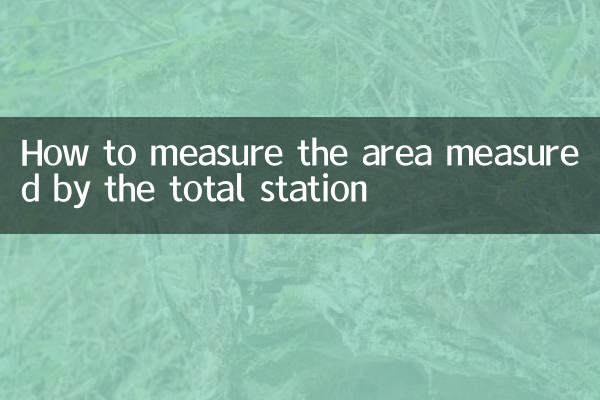How to measure the area measured by the total station
Total station is a high-precision measurement instrument integrating light, mechanical and electrical, and is widely used in terrain measurement, engineering stakeout, area calculation and other fields. This article will provide detailed descriptions on how to measure area using a total station and provide structured data for easy understanding.
1. Basic principles of total station measurement area

The total station automatically calculates the area of the closed area by measuring the coordinates of the target point (X, Y, Z) and uses polygonal area calculation formulas (such as shoelace formulas). The core steps are as follows:
1. Set up a station: set up the total station at a known point or set up a station to complete centering, leveling and orientation.
2. Collect boundary point coordinates: measure the boundary points of the target area in turn to form a closed polygon.
3. Automatically calculate area: The built-in software of the instrument automatically calculates area based on coordinate data and displays the results.
2. Detailed explanation of the operation steps
The following is the specific operation process for measuring area using a total station:
| step | Operation content | Things to note |
|---|---|---|
| 1 | Installation of instruments | Ensure the centering error is ≤2mm and the bubbles are centered |
| 2 | Create a new project | Set the correct coordinate system and unit |
| 3 | Measure boundary points | Measure in clockwise or counterclockwise order |
| 4 | Closed polygons | The last point needs to be coincident with the starting point |
| 5 | View the results | Check whether the area value and unit meet the requirements |
3. Comparison of technical parameters
There are differences in area measurement functions of total stations of different brands. The following is the performance comparison of mainstream models:
| Brand model | Ranging accuracy | Area calculation speed | Maximum points |
|---|---|---|---|
| Leica TS16 | ±1mm+1.5ppm | 0.5 seconds | 999 points |
| Topcon ES-105 | ±2mm+2ppm | 1 second | 500 points |
| Trimble S7 | ±1mm+1ppm | 0.3 seconds | 1500 points |
4. Frequently Asked Questions
In actual operation, you may encounter the following problems:
1.The area is displayed as 0: Check whether the closed measurement is completed. The last point must be consistent with the starting point coordinate.
2.The value is abnormally large: Confirm whether the unit is set correctly (square meter/hectare/mu).
3.Coordinate drift: Re-direct the rearview and check the prism constant settings.
5. Application scenario cases
Total station area measurement has significant advantages in the following scenarios:
| Application areas | Measurement object | Typical accuracy requirements |
|---|---|---|
| Land rights confirmation | Farmland/Household | ±0.1㎡ |
| Project acceptance | Building Plan | ±0.05㎡ |
| Forestry Investigation | Woodland outline | ±0.5㎡ |
6. Accuracy improvement skills
1. Increase boundary point density: For irregular areas, it is recommended to set a measurement point every 5-10 meters.
2. Use tripod mode: Avoid shaking errors caused by hand-held prisms.
3. Temperature compensation: The meteorological correction function must be enabled in extreme temperatures.
4. Repeat measurements: At least two independent measurements should be made in important areas to average.
Through the above methods and precautions, the accuracy and reliability of the total station area measurement results can be ensured. In actual operations, standardized operations must be carried out in combination with the operating manual of specific instruments.

check the details

check the details